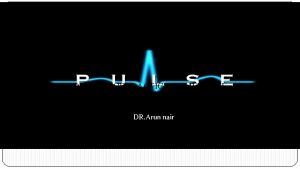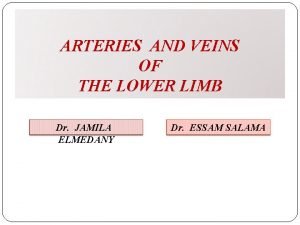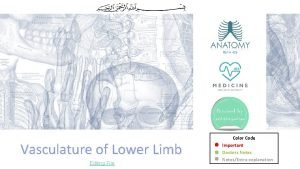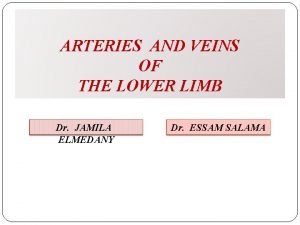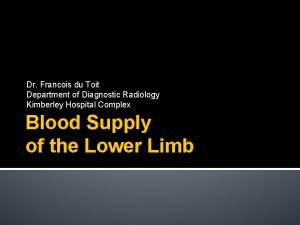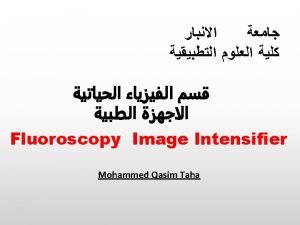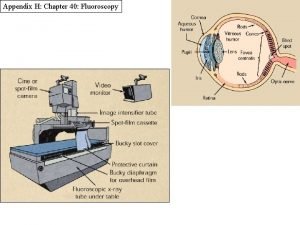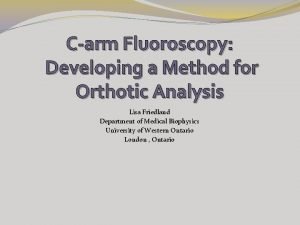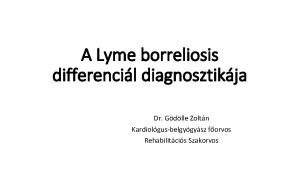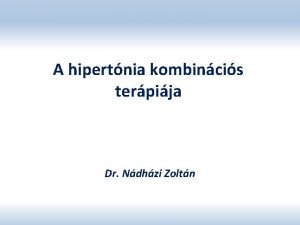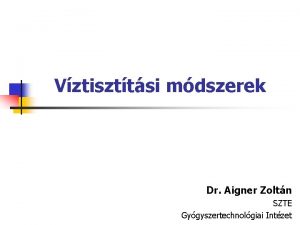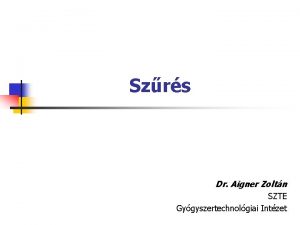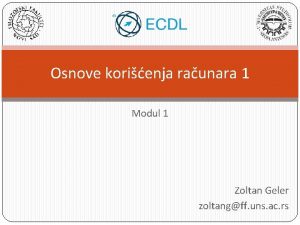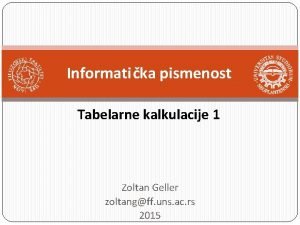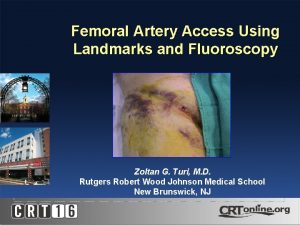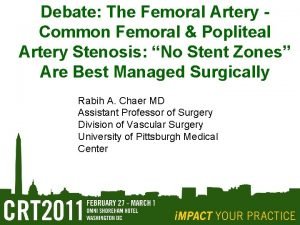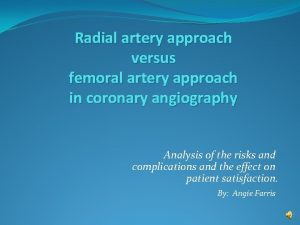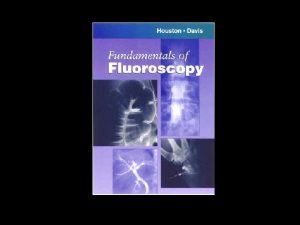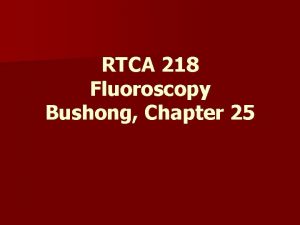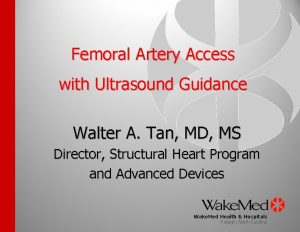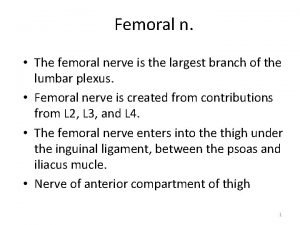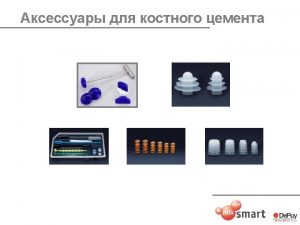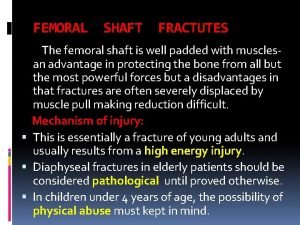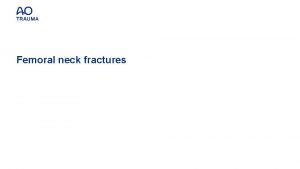Femoral Artery Access Using Landmarks and Fluoroscopy Zoltan

































- Slides: 33

Femoral Artery Access Using Landmarks and Fluoroscopy Zoltan G Turi MD, MSCAI Seton Hall University School of Medicine Hackensack University Medical Center

Disclosure Statement of Financial Interest Zoltan Turi MD, MSCAI Clinical Events Committee - Mitralign Research Support - Abbott Vascular Training Grant Support - Abbott Vascular, Medtronic

Step 1 Recognize That Vascular Access in the New Percutaneous Technologies Era is: Taken for Granted Under-investigated but Way Over-represented in Complications

TAVR Complications NEJM 2010

Usual Approach • Keep poking until you get a gusher

Step 2 – Choose a Landmark 3. Bone landmarks X 2. Maximal pulsation 4. Prior puncture site 1. Inguinal crease X

Landmarks Used for Femoral Puncture All Three 1% Skin Crease Maximum Pulse Bony Landmarks Pulse/Bone 7% Crease/Bone 1% Crease/Pulse 13% Crease 40% Bone 13% Pulse 25% Skin Crease Most Common Grier D. Br J Radiol 1990; 63: 602.

Inguinal Crease UC San Diego New Jersey

This is NOT Normal Anatomy CFA PFA SFA 3 Misconceptions despite 60 years experience

Stick at the crease • Right at the inguinal crease • Steep angle of attack • Some difficulty with inserting sheath over wire

PFA

Odds Ratio RPH 18: 1

Femoral Artery Anatomy: A Prospective Study • 200 consecutive patients • All undergoing coronary angiography • Femoral angiography at end of procedure • Quantitative angiography Schnyder et al CCI 2001

Femoral Head and the CFA Bifurcation 1. 5% 4. 0% 17% V 55. 5% IV 22% III II I I: III: IV: V: Number of patients 111 44 34 8 3 Below inferior border At inferior border Below center of head At center of head Above center of head n=200

Femoral Angiogram LAO RAO


Common Femoral Artery – Classic Measurements • From top of femoral head to femoral bifurcation • Does not take IEA into consideration • Does not consider implications of CFA stick above bifurcation, but below femoral head

Target Zone

Centerline Target Zone TYPE 1

TYPE 2 Centerline Target Zone

Cumulative Probability of Being Outside Target Zone Above FH Centerline Below

IEA FH Centerline Cumulative Target Zone BIF

Step 3 – Iterative Fluoroscopy

N=296

Fluoro guidance is not just using a hemostat 56% Abu-Fadel CCI 2009

How to Decrease Risk of Complications 1. Access using fluoroscopy and/or ultrasound 2. Needle entry below centerline of femoral head 3. Femoral angiogram regardless of closure device use 4. Proceed to PCI (and anticoagulate) only if puncture in safe zone

How to Decrease Risk of Complications 1. Access using fluoroscopy and/or ultrasound 2. Needle entry below centerline of femoral head 3. Femoral angiogram regardless of closure device use 4. Proceed to PCI (and anticoagulate) only if puncture in safe zone

How to Decrease Risk of Complications 1. Access using fluoroscopy and/or ultrasound 2. Needle entry below centerline of femoral head 3. Femoral angiogram regardless of closure device use 4. Proceed to PCI (and anticoagulate) only if puncture in safe zone

How to Decrease Risk of Complications 1. Access using fluoroscopy and/or ultrasound 2. Needle entry below centerline of femoral head 3. Femoral angiogram regardless of closure device use 4. Proceed to PCI (and anticoagulate) only if puncture in target zone

How to Decrease Risk of Complications 1. Access using fluoroscopy and/or ultrasound 2. Needle entry below centerline of femoral head 3. Femoral angiogram regardless of closure device use 4. Proceed to PCI (and anticoagulate) only if puncture in target zone 5. Use micropuncture

Step 4 – Micropuncture • Micropuncture


The Way To The Heart Is Through The Wrist: Radial Catheterization Comes To America (Finally)
 Digital fluoroscopy vs conventional fluoroscopy
Digital fluoroscopy vs conventional fluoroscopy Branches of femoral artery
Branches of femoral artery Femoral canal and femoral sheath
Femoral canal and femoral sheath Canal de hunter
Canal de hunter Tibial pulse location
Tibial pulse location Ascoltation
Ascoltation Dorsalis pedis artery pulse location
Dorsalis pedis artery pulse location Anterior tibial pulse
Anterior tibial pulse Dorsalis pedis pulse
Dorsalis pedis pulse Lower extremity arteries and veins
Lower extremity arteries and veins Profunda femoris
Profunda femoris Celiac artery and mesenteric artery
Celiac artery and mesenteric artery Real time fluoroscopy
Real time fluoroscopy Aspurbi
Aspurbi Spot film fluoroscopy
Spot film fluoroscopy Carm fluoroscopy
Carm fluoroscopy Derzsényi attila
Derzsényi attila Dr. pataki zoltán
Dr. pataki zoltán Dr lantos zoltán
Dr lantos zoltán Dr. zoltan grossman
Dr. zoltan grossman Heiko jacobi
Heiko jacobi Dr. hella zoltán
Dr. hella zoltán Polgár zoltán
Polgár zoltán Borrelia recurrentis treatment
Borrelia recurrentis treatment Dr nádházi zoltán
Dr nádházi zoltán Aqua destillata vs aqua purificata
Aqua destillata vs aqua purificata Elektronska ucionica ffuns
Elektronska ucionica ffuns Aigner zoltán
Aigner zoltán Dr. aigner zoltán
Dr. aigner zoltán Zoltan geler
Zoltan geler Zoltan geler
Zoltan geler Zoltan geler
Zoltan geler Nagy zoltán sze
Nagy zoltán sze Zoltan geler
Zoltan geler




